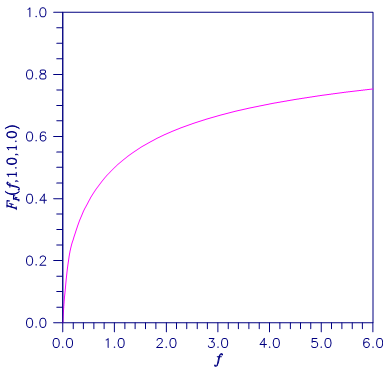fCdf¶
Evaluates the F distribution function.
Synopsis¶
fCdf (f, dfNumerator, dfDenominator)
Required Arguments¶
- float
f(Input) - Point at which the F distribution function is to be evaluated.
- float
dfNumerator(Input) - The numerator degrees of freedom. Argument
dfNumeratormust be positive. - float
dfDenominator(Input) - The denominator degrees of freedom. Argument
dfDenominatormust be positive.
Return Value¶
The probability that an F random variable takes a value less than or equal
to the input point, f.
Description¶
Function fCdf evaluates the distribution function of a Snedecor’s F
random variable with dfNumerator and dfDenominator. The function is
evaluated by making a transformation to a beta random variable, then
evaluating the incomplete beta function. If X is an F variate with
\(\nu_1\) and \(\nu_2\) degrees of freedom and \(Y=(\nu_1
X)/(\nu_2+\nu_1 X)\), then Y is a beta variate with parameters
\(p=\nu_1/2\) and \(q=\nu_2/2\). Function fCdf also uses a
relationship between F random variables that can be expressed as
where \(F_F\) is the distribution function for an F random variable.

Figure 11.6 — Plot of \(F_F(f,1.0,1.0)\)
Example¶
This example finds the probability that an F random variable with one numerator and one denominator degree of freedom is greater than 648.
from __future__ import print_function
from numpy import *
from pyimsl.stat.fCdf import fCdf
f = 648.0
df_numerator = 1.0
df_denominator = 1.0
p = 1 - fCdf(f, df_numerator, df_denominator)
print("The probability that an F(1,1) variate is greater than 648 is %6.4f" % p)
Output¶
The probability that an F(1,1) variate is greater than 648 is 0.0250